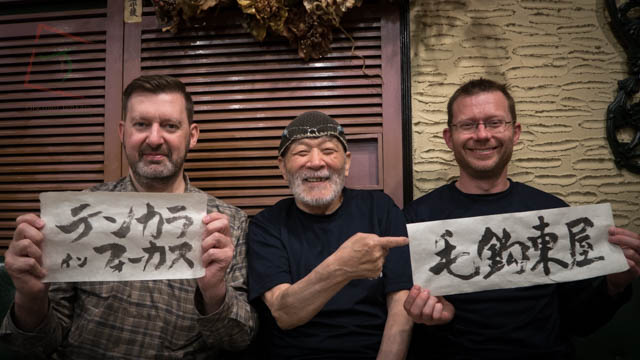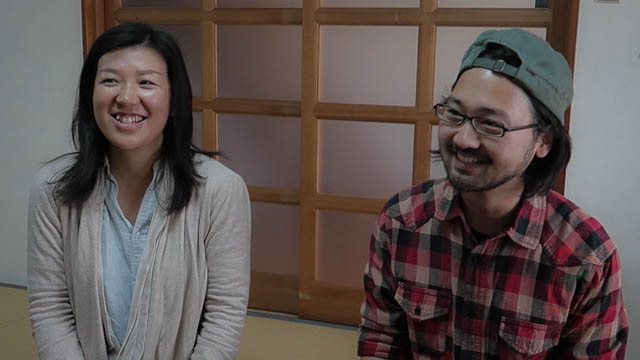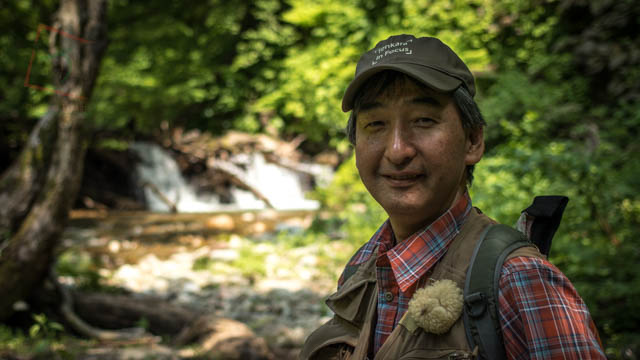We were incredibly lucky to meet Yuzo Sebata – one of tenkara’s truly legendary characters on our spring 2017 trip to Japan. But just before our trip, we heard some terrible news.
Just a day after hearing that our friend and conservation pioneer Shouichi Saitou had suffered a heart attack – we also got the worrying news that Sebata-san (who, unlike Saitou-san, we had never spent time with in person before) had also had suffered a serious illness. And since we did not have that personal connection with Sebata san or his family, it did not seem appropriate to pass the news on and offer to pass on well-wishes from the tenkara community in the way that we were comfortable to do for Saitou-san.

It makes me very happy, therefore, to say as I write this that Sebata-san is now making a good recovery and that he was well enough to meet and talk to us at his favourite café in Tokyo. Similarly, while Saitou san was not yet well enough to meet us in Itoshiro, we were delighted that his son (Jun-san) and daughter-in-law (Mariko-san) did us the great honour of spending time with us and passing on news, overwhelming gifts and messages from a recovering Saitou-san too. We hope to share the video of both these meetings with you soon, so keep a look out for it (the picture of Mariko and Jun below is a freeze-frame taken from one of those videos)…

Though turning to Sebata-san for a moment; you may be wondering what makes him such a legend – and what is his contribution to tenkara fishing?
Well, before Sebata-san started tackling the most difficult to reach headwater streams in Japan – using the river system as a line of weakness to access the harsh, trail-less areas of remote mountain-sides so he could fish pristine streams – there was really NOBODY doing anything quite like that. Not as a hobby anyway!
The “bu-ru shi-to” (blue-sheet!) was quite a new thing when Sebata-san began using it. It is a very basic, foldable (blue) tarp that can be used to make a simple shelter and is relatively easy to pack and carry. Reports vary on how waterproof you should expect “burushito” to be… (you have been warned)
A great deal of climbing (including up waterfalls and traversing wet rock above fast-flowing deep water) as well as swimming – or even roped “pendulum-style” crossing of the fastest currents – are all part of the genryu fishing style that Sebata-san pioneered (you can read more about genryu, keiryu and honryu streams here if you want a bit more info: https://www.discovertenkara.com/whats-the-link-between-organised-violence-and-japa/ and https://www.discovertenkara.com/keiryu-tenkaraand-honryu-tenkara/).
Basically, all those pioneering activities fall squarely into the “don’t try this at home” school.
Don’t forget that the climbing would be undertaken with a large rucksack and there would often be long, sustained scrambles up and over the top of one valley-side to reach into neighbouring valleys. Not for the faint-hearted.
One of the very cool ideas at the heart of “Sebata-san” tenkara is the idea of setting out at the valley-bottom of a river system and then to go on a quest to reach the “Uodome-no-taki” on the remote headwater.
Roughly translated “Uodome-no-taki” means “Fish-stopping-waterfall”.
In other words, the barrier above which the stream no longer holds any fish – an impassable limit. Perhaps not surprisingly, the cult of genryu fishing that now boasts a dedicated band of followers is full of related ideas and its own “insider” terms. For example, you can see an extension of the Uodome-no-taki in the term “Kuruma-dome”; where “kuruma” is a common word for “car”.
So this is the furthest point that it is possible to travel into the mountains by vehicle…the “car-stopping obstacle”…It’s all on foot, hand-holds and swimming after you park up at the kuruma-dome for any river system.
That transformation of the landscape and atmosphere as you progress through a genryu quest is a key part of the experience – so much so that there are names that recognise how the stream changes character along its course. These different “faces” of each section of stream, their recognition and naming of their unique personalities is highly revealing of Japanese anglers’ deep understanding of rivers, fish and fishing. It is not only found in genryu fishing. For instance, anywhere that you find well-featured tenkara water; a stream is often described as having “Kei-so”…
“Kei-so” (derived from “keiryu”) translates as a stream that has a good “tenkara face”. Its characteristic complex currents, rocks and gradient making it an ideal playground for tenkara. Getting even more specific (and narrowing down to smaller details) I’ll be talking a lot more in future content about concepts such as “Kui-nami” and “Yodomi” – which are both highly specific current features with great importance to anglers. But they are a bit beyond the scope of this piece…
While I’ve introduced these ideas and terms here in an incredibly brief and superficial way, I’ll be asking one of today’s keenest genryu fishing practitioners (and good friend of Sebata-san) Keiichi Okushi to expand on the specific names given to the different “faces” of a river as you follow it upstream.

Keiichi’s own thoughts and those of the wider network of friends who pursue genryu fishing today are a very valuable resource for the global tenkara community. You may be familiar already with his Japanese online store “Tenkara-ya” and his writings on genryu fishing on the Tenkara-fisher site. If so you’ll appreciate how fortunate we were to share a day hiking and fishing up a stream with pretty gentle terrain with Keiichi (pictured above on that very trip) and bamboo fly-rod fisher Hide Yoshida (who we got some nice footage of as well).
It was a genuinely lovely experience (and again will feature in upcoming video content). I know that you’ll get a ton of interesting and valuable insights from all that Keiichi shares with Discover Tenkara in future, but I need to steer myself back on track with this story…
Although known for his tenkara – Sebata-san’s main focus is not even really the fishing itself.
He feels that it’s far more important to be in the place where genryu tenkara fishing can happen and to truly accept and appreciate nature in those wild, remote settings. In Sebata-san’s philosophy, this acceptance and appreciation means that he doesn’t pay much mind to biting insects and doesn’t even remove leeches from his skin because “they need their meal too”. He completely accepts his place in the ecosystem and the food-chain. Totally at one with his surroundings.
So perhaps it is things like this that mean you can start to see the power and fierce pride inside Sebata-san’s slight frame? His legend needs far more explanation though, and I’ll try to make a start here…
The length of time taken to explore and finally reach the fishing areas means that, by necessity, fishing makes up only a quite limited proportion of the total activity. The adventure, absence of established trails, foraging and cooking, time spent with friends, the difficulty of the terrain, the practicing of survival skills and really immersing oneself in nature – these were the real substance of genryu trips.
In fact, the real depth of skill is in being able to survive and successfully navigate into and out of those areas – more so than an obsessive refinement of tenkara techniques (such as you might find in the tenkara addicts who fish the very accessible – and hence popular – keiryu and honryu rivers). In genryu fishing, you earn the right to cast at fish that have probably never seen a kebari (fly) before – simply because you are willing to travel and survive in conditions that almost nobody else is able to cope with. In those places, iwana can grow large – even in the smallest streams, so the prize for your commitment can be great.
To lead one of those expeditions and take on responsibility for the varying levels of experience of people following you requires great calmness, consideration and strength of character. You need to be sure of your own abilities and VERY clear on the limitations, strengths and personalities of everyone in your group too. Anyone who has those qualities is almost always an incredibly charismatic person – and that is the most fitting description of Yuzo Sebata. He draws people around him and everyone loves to be in his company. To be with him when he was in the prime of his life must have been quite extraordinary.
Over the course of all our tenkara pilgrimages to Japan, we’ve grown to know and love the different “personalities” of the main fish species targeted by fly fishers and tenkara anglers. So, for instance the incredibly beautiful, deep-bodied yamame and amago living in the most powerful “honryu” (main-river) reaches inspire a loyal following of obsessive anglers.
And while you commonly find sections of river where yamame, amago and iwana all live together, as you progress further upstream, the first two species begin to drop away…Until just one is left; the indomitable iwana (they don’t stop fighting once you get them in your net, which makes them quite challenging to photograph sometimes!). This character of iwana means it is always questing upstream…
And that is just like Sebata-san…They are a perfect match.
Iwana also live much longer than amago and yamame. This is how, as long as they are not caught and eaten, they can grow large in the modest pool of water that becomes their territory for many years.
They, too, become one with their environment over time – and you already know this is a quality shared by Sebata san – but also by the ancient nomadic bear-hunting clans known as the Matagi. In fact, much of what Sebata-san enjoys as a hobby would have been part and parcel of the survival skills needed by the Matagi…
It seems entirely fitting, then, that Sebata-san loves to use old Matagi temporary hunting caves for shelter and as a wonderful place for everyone on a genryu trip to rest and eat together. Not only that, there will probably have been many times when genryu-angling expeditions will have benefited from another wily practice of Matagi down the years too…
You see, it was quite common for Matagi to transplant some iwana above obstacles in the stream so that they could colonise previously empty headwaters. This produced a kind of “living food cache” for those groups of bear-hunters in future years – which might save their lives on a “hunting expedition gone bad” by providing protein in a place where it was previously absent.
It also means that a new obstacle, further upstream, now becomes the “uodome-no-taki”; so Sebata-san and friends could enjoy exploring even higher up towards the source of each river.
Now, because I am talking about a man who has lived through such a huge number of wild adventures, this piece can only scratch the surface of the Legendary Sebata-san. I hope even this small introduction might explain why I love to wear his T-shirt (with the brilliant “Sebatake-kun” cartoon character printed on and that Daniel Galhardo mentioned a few years ago). Keiichi sells these through Tenkara-ya if you’d like one too.
I’ve not even had chance to go into what a wonderful chef he is – did you know he ran a restaurant for many, many years in Tokyo (between his extended adventures into the mountains)? That let him fund his adventures away from his home in Tokyo, up into the mountains he loves so much. It also made the camp meals extra special for those lucky (and tough) enough to accompany Sebata-san. In fact, when I asked him which came first, he said that his love and understanding for foraged food (won over long experience) was what enabled him to become a chef – rather than the other way around.
His expertise in “sansai” (the wild plants that are often gathered from areas surrounding mountain streams in Japan) as well as fungi obviously gave him a very good background in understanding ingredients. After all, it is not everyone who can complete a long career as a professional chef and restauranteur in Tokyo…
As we said our goodbyes with Sebata-san outside his favourite café, he collected his bike from the side of the building and began walking along the road, leaning on the handlebars. The effects of his illness and also, I suspect, the pain in his joints from a lifetime of mountaineering made us a little bit worried for him; though we all saw how clever it was to use the bike for support in that way. It was just the same way that other folks his age might use a walking frame…
But, as ever, the little “tough-guy of the mountains” had one last surprise for us as he swung himself up onto the seat and peddled away, weaving through the bustle of traffic and pedestrians on this busy back-street of Tokyo. We watched him (while shaking our heads and smiling) make his way towards home in the afternoon sunshine for as long as we could; right until the crowd and the streets swallowed him from view.
Just so you know; never underestimate the little guy in life, you don’t know what steel lies behind those laughing eyes…
Paul
PS – watch out for the gonzo video of the interview we shot with Sebata-san in the cafe – the story he tells is absolutely hilarious…You can make sure you don’t miss it by subscribing to the Tenkara in Focus Youtube channel.

Sebata-san basically established this Genryu Fishing culture and I remember in grade school (30+ years ago!) reading about him.
I’ve always felt like he deserved more recognition outside Japan now that the term Tenkara has gained popularity. This is a wonderful piece of writing and report on Sebata-san. Can’t wait to see DT put more contents out about Sebata-san in the future.
Great work!
Many thanks Go, that is awesome feedback – I really appreciate it. Yes, while I am far from an expert on Sebata-san’s rich and varied life; having had chance to talk to him just a little about it I am quite surprised at how superficial the English-language coverage of him has been so far. It seems strange that we haven’t heard a lot more about his philosophies, wild adventures and what he’d really like the wider tenkara community to understand about the places and activities he loves so much.
Tremendous, descriptive story telling. Loved it Paul. Thank you
Cheers Neil,
Sebata san, Keiichi-san, Yoshida san, Saitou san and their respective groups of friends, family and followers are so full of stories that it is a complete gift for a writer.